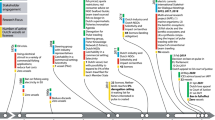Abstract
This paper seeks to explain the circumstances under which using total allowable catch (TAC) as an instrument to manage a fishery along with fishing periods may be of interest from a regulatory point of view. The deterministic analysis by Homans and Wilen (J Environ Econ Manag 32:1–21, 1997) and Anderson (Ann Oper Res 94:231–257, 2000) is thus extended to a stochastic scenario where the resource cannot be measured accurately. The resulting model is solved numerically to find the optimal control rules in the Iberian sardine stock. Three relevant conclusions can be highlighted from simulations: first, the greater the uncertainty regarding the state of the stock, the lower the probability of the fishery being closed before the end of the fishing period. Second, the use of TACs as a management instrument in fisheries that are already regulated by fishing periods leads to: (i) an increase in the optimal season length and harvests, especially for medium and high numbers of licences; (ii) improved biological and economic variables when the fleet is large; and (iii) extinction risk for the resource being eliminated. Third, the regulator would rather select the number of licences than restrict the season length.
Similar content being viewed by others
References
Anderson LG (2000) Open access fisheries utilization with an endogenous regulatory structure: an expanded analysis. Ann Oper Res 94: 231–257
Arnason R (2000) Endogenous optimization fisheries models. Ann Oper Res 94: 219–230
Bjørndal T, Brasão A (2006) The East Atlantic bluefin tuna fisheries: stock collapse or recovery?. Marine Res Econ 21: 193–210
Bjørndal T, Gordon D, Kaitala V, Lindroos M (2004a) International management strategies for a straddling fish stock: a bio-economic simulation model of the Norwegian spring-spawning herring fishery. Environ Res Econ 29: 435–457
Bjørndal T, Ussif A, Sumaila R (2004b) A bioeconomic analysis of the Norwegian spring spawning herring (NSSH) stock. Marine Resour Econ 19: 353–365
Clark GW, Kirkwood GP (1986) On uncertain renewable resource stocks: optimal harvest policies and the value of stock surveys. J Environ Econ Manag 13(3): 235–244
Council Regulation (EC) No 1288/2009 of 27 November 2009 Establishing Transitional Technical Measures from 1 January 2010 to 30 June 2011
Da Rocha JM, Gutiérrez MJ, Cerviño S (2010) An endogenous bio-economic optimization algorithm to evaluate recovery plans: an application to southern hake. ICES J Marine Sci 67(9): 1957–1962
Da Rocha JM, Gutiérrez MJ (2011) Lessons from the northern hake long-term management plan: could the economic assessment have accepted it. ICES J Mar Sci 68(9): 1937–1941
Danielsson A (2002) Efficiency of catch and effort quotas in the presence of risk. J Environ Econ Manag 43: 20–33
Diekert FK, Hjermann DO, Naevdal E (2010) Spare the young fish: optimal harvesting policies for North-East Arctic cod. Environ Res Econ 47: 455–475
Hannesson R, Steinshamn S (1991) How to set catch quotas: constant effort or constant catch. J Environ Econ Manag 20: 71–91
Homans FR, Wilen JE (1997) A model of regulated open access resource use. J Environ Econ Manag 32: 1–21
ICES (2007) Report of the working group on the assessment of Mackerel, Horse Mackerel, Sardine and Anchovy (WGMHSA), 4–13 September 2007, ICES Headquarters. ICES CM 2007/ACFM:31. 712 p
IPHC (2009) Annual Report. ISSN: 0074-7238. http://www.iphc.washington.edu/publications/annual/ar2009.pdf
Kirkley CJ, Morrison P, Cunningham S, Catanzano J (2004) Embodied and disembodied technical change in fisheries: an analysis of the Sète trawl fishery, 1985–1999. Environ Res Econ 29(2): 191–217
Kompas T, Tuong NC, Quentin R (2008) Fisheries instrument choice under uncertainty. Land Econ 84(4): 652–666
Lazkano I (2008) Cost structure and capacity utilization in multi-product industries: an application to the Basque trawl industry. Environ Res Econ 41(2): 189–207
Quiggin J (1992) How to set catch quotas: a note on the superiority of constant effort rules. J Environ Econ Manag 22(2): 199–203
Reed WJ (1979) Optimal escapement levels in stochastic and deterministic harvesting models. J Environ Econ Manag 6: 350–363
Sethi G, Costello C, Fisher A, Hanemann M, Karp L (2005) Fishery management under multiple uncertainty. J Environ Econ Manag 50: 300–318
Suris J (1993) Regulation of the iberoatlantic sardine fishery. Environ Res Econ 3(5): 457–470
Tahvonen O (2009) Economics of harvesting age-structured fish populations. J Environ Econ Manag 58: 281–299
Weitzman ML (2002) Landing fees vs harvest quotas with uncertain fish stocks. J Environ Econ Manag 43(2): 325–338
Author information
Authors and Affiliations
Corresponding author
Additional information
This paper has benefited from comments and suggestions by the Editor, David Finnoff, and two anonymous referees. Financial aid from the European Commission (MYFISH, FP7-KBBE-2011-5), the Spanish Ministry of Education and Science (SEJ2006-12793/ECON, ECO2009-14697-C02-01) and the Basque Government (HM-2008-1-13) is gratefully acknowledged. The first draft of the paper was written while Jose Maria Da Rocha was visiting Institut d’Analisi Economica-CSIC. He gratefully acknowledges the hospitality of Institut d’Analisi Economica-CSIC.
Rights and permissions
About this article
Cite this article
Da Rocha, J.M., Gutiérrez, M.J. Endogenous Fishery Management in a Stochastic Model: Why Do Fishery Agencies Use TACs Along with Fishing Periods?. Environ Resource Econ 53, 25–59 (2012). https://doi.org/10.1007/s10640-012-9546-6
Accepted:
Published:
Issue Date:
DOI: https://doi.org/10.1007/s10640-012-9546-6




